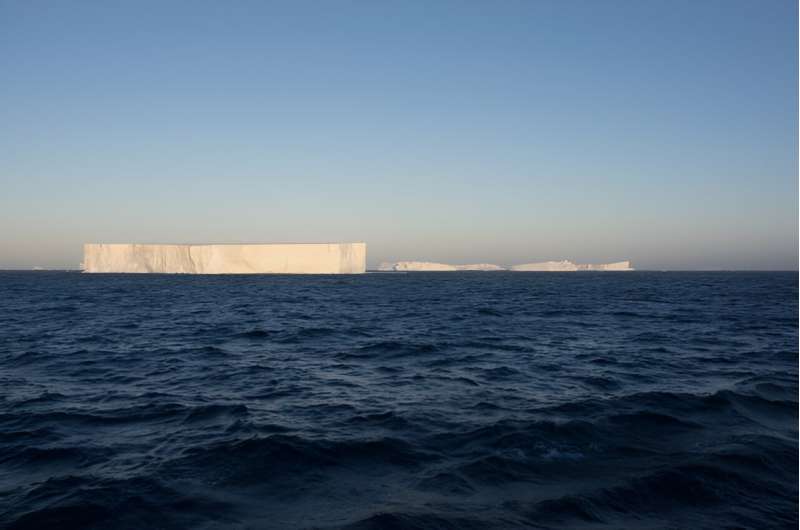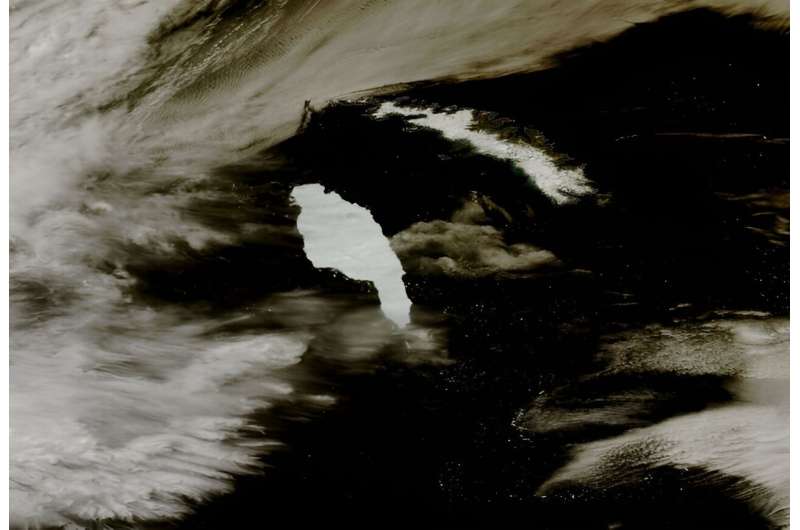This article has been reviewed according to Science X's editorial process and policies. Editors have highlighted the following attributes while ensuring the content's credibility:
fact-checked
peer-reviewed publication
trusted source
proofread
Study explores supergiant iceberg's huge impact on surrounding ocean surface

The melting of the supergiant iceberg A-68 had a huge impact on the ocean around South Georgia, in sub-Antarctica, and significantly changed the Southern Ocean's temperature and saltiness, with potentially major consequences for this ecologically significant region. These results are published this week in the journal Geophysical Research Letters.
In 2020, A-68—a supergiant iceberg about the size of Luxembourg that calved from the Larsen C ice shelf in 2017—drifted very close to South Georgia before starting to break up, releasing huge quantities of fresh, cold meltwater in a relatively small region.
Researchers from British Antarctic Survey and University of Sheffield used satellite data to observe how the melting iceberg affected the temperature and saltiness, or salinity, of the top few centimeters of the ocean surface.
They observed the meltwater caused extreme anomalies in the temperature and saltiness of the waters at the ocean surface, of magnitudes that have not been reported for any previous iceberg disintegration so far. Researchers recorded temperatures up to 4.5°C colder than average. The salinity was reduced by more than 10 psu (a way of measuring the amount of salt in water) meaning the surface ocean became around two-thirds of its normal saltiness.
This "signal" from the melted iceberg eventually extended well beyond South Georgia; it was carried by ocean currents to form a long plume that stretched up to more than 1,000km across the South Atlantic—roughly the distance from Land's End to John O'Groats.
The meltwater signal also took a long time to disappear—it was still visible more than two months after the iceberg disintegrated.

These changes to the physical conditions at the ocean surface have important links to the biological conditions. For example, meltwater contains dissolved iron which stimulates the growth of microscopic plants called phytoplankton that form the base of the ocean's food web.
However, this meltwater can also have negative impacts, altering the temperature, salinity and nutrient conditions that many of the Southern Ocean's inhabitants are adapted to thrive in.
The calving of this massive iceberg created a unique opportunity to assess the impact melting on surface ocean conditions.
Climate scientist Roseanne Smith at British Antarctic Survey and co-author of the study said, "The A-68 iceberg was one of the largest and most studied of all icebergs. When it started to break apart, it was a bit like installing a major river estuary into the open ocean, pumping cold, freshwater into the surface layer.
"Our results show that each individual melting giant iceberg can have widespread and long-lasting impacts on the conditions at the surface of the Southern Ocean, and this has consequences for the plant and animal life that lives there."
Emeritus Professor Grant Bigg, from the University of Sheffield, said, "This is the largest iceberg whose impact on the Southern Ocean has been tracked for all of its lifetime, with this impact being widespread and long-lasting. We know it collided with the continental shelf off South Georgia, so it will have left long term scars on the seafloor there, as well as the major ocean cooling and freshening likely changing local ocean surface flows.
"Climate change is likely to see more giant iceberg calving in the future; it is important to monitor these so future impacts on ocean circulation, biology and seafloor geology can be assessed and predicted."
Almost half the mass lost from the Antarctic Ice Sheet is from calved icebergs—they release huge quantities of cold, fresh water as they drift and break up, affecting the temperature and salinity of the Southern Ocean. These changes have wide ranging impacts, such as affecting sea ice growth and local currents, and also releases nutrients and iron into the water, stimulating primary production.
Supergiant icebergs, like A-68, may become more common in the future as the climate warms, causing Antarctic ice shelves to break up.
More information: R. M. Smith et al, Impact of Giant Iceberg A68A on the Physical Conditions of the Surface South Atlantic, Derived Using Remote Sensing, Geophysical Research Letters (2023). DOI: 10.1029/2023GL104028
Journal information: Geophysical Research Letters
Provided by British Antarctic Survey




















